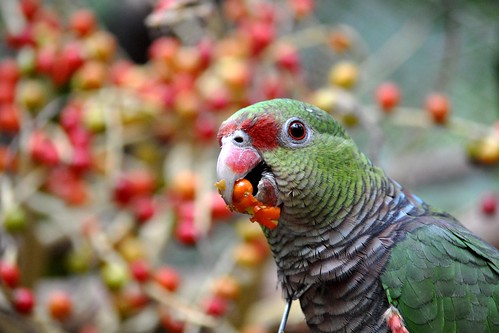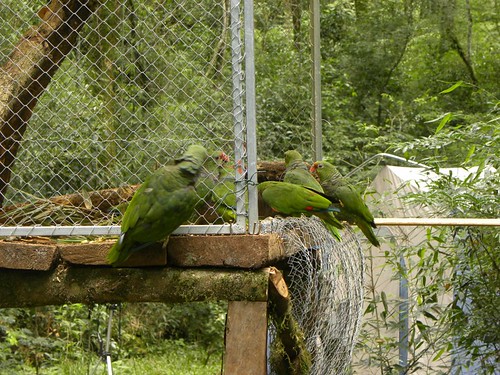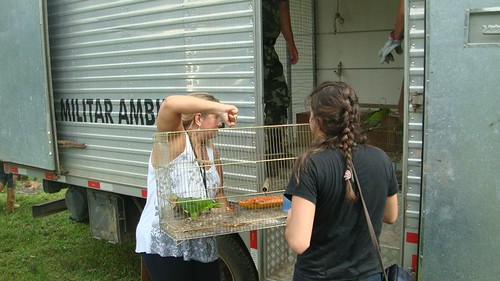 Vinaceous-breasted Amazon (Amazona vinacea) learning to eat the spoils of it's native forest so it will be able to utilise it after release. Image by Vanessa Tavares Kanaan An innovative approach to the reintroduction of 15 Vinaceous-breasted Amazons in Araucaria National Park (SC)
Vinaceous-breasted Amazon (Amazona vinacea) learning to eat the spoils of it's native forest so it will be able to utilise it after release. Image by Vanessa Tavares Kanaan An innovative approach to the reintroduction of 15 Vinaceous-breasted Amazons in Araucaria National Park (SC)
The Vinaceous-breasted Amazon (Amazona vinacea) is a species endemic to the Atlantic Forest. Originally the species inhabited Brazil from Bahia to Rio Grande do Sul and southeastern Paraguay and northeastern Argentina. This species is typical for the region but was extinct at the Araucaria National Park located in Santa Catarina national park for at least 20 years. The species does occur in other areas of the state.
But an innovative project, which began in August 2010, is beginning to reap its first results in Santa Catarina. The researchers' goal was to reintroduce 15 Vinaceous-breasted Amazon back to the wild. The birds where confiscated from the illegal bird trade and remained in captivity at the Florianópolis CETAS facilities until January this year. During the four months prior to release, the parrots underwent a daily training schedule aimed at enhancing their flight stamina and developing wing muscle. But not just that.
 Released birds a provided with natural foods when at the release cages to aid their transition to live in the wild. Image by Espaço SilvestreWhen the parrots would approach people they were presented with a noninvasive aversive stimulus so they would no longer associate human presence with pleasurable events. Generally the stimulus was a loud noise. Now that the birds have lost their bonds with people they are ready to live life on their own.
Released birds a provided with natural foods when at the release cages to aid their transition to live in the wild. Image by Espaço SilvestreWhen the parrots would approach people they were presented with a noninvasive aversive stimulus so they would no longer associate human presence with pleasurable events. Generally the stimulus was a loud noise. Now that the birds have lost their bonds with people they are ready to live life on their own.
The birds have been given natural foods in order to strengthen their food handling behavior. Food was available on platforms built at the top of their enclosures, in hollow logs and/or hung from the aviary roof, so that the parrots were encouraged to forage and to not stay on the ground where predators may lurk. To determine if the strategy was working, researchers weighed the animals every 15 days and adapted the diet according to the average weight of the group.
Of the 22 individuals, six parrots failed the flight capacity test and therefore were not selected for release. A total of 16 animals had reached the projected requirements. 8 of these animals were fitted with dummy radio-collars thirty days before the release to get used to the weight of this equipment. The collars do not exceed 5% of their body weight. Eventually four of the birds were radio-collared for real three days before being taken to the release site.
In laboratory tests prior to release, one parrot showed blood parasites and the project veterinarians choose not to release it. During their time in captivity 2 birds died, one due to an Escherichia coli infection, and another due to an unidentified parasitic infestation.
Fifteen animals received metal bands provided by the National Research Center for Conservation of Wild Birds (CEMAVE), linked to ICMBio. Which will help to monitor the birds in the wild after release.
 Transport to the release site was made possible by the Environmental Police of Santa Catarina. Image by Institute Carijós Transportation to the release site was done by Environmental Police of Santa Catarina in an air-conditioned truck and accompanied by one of the project veterinarians. The animals were placed in temporary aviaries, at the release site, measuring 4m x 2m x 2m, where they remained for four days before release. Biologist have been monitoring the released birds ever since.
Transport to the release site was made possible by the Environmental Police of Santa Catarina. Image by Institute Carijós Transportation to the release site was done by Environmental Police of Santa Catarina in an air-conditioned truck and accompanied by one of the project veterinarians. The animals were placed in temporary aviaries, at the release site, measuring 4m x 2m x 2m, where they remained for four days before release. Biologist have been monitoring the released birds ever since.
The biologist Joice Reche Pedroso and Vanessa Tavares Kanaan, of the Institute Espaço Silvestre/Institute Carijós Pro-Conservation of Nature, are preparing a new group of Vinaceous-breasted Amazons for release. Data obtained from monitoring this first group, increase the chances of successful reintroduction of successive releases. Support is given by the head of the Araucaria National Park and the colleagues of the Black Forest Ecological Station of and Wildlife Refuge dos Campos de Palmas.